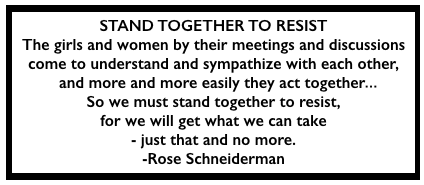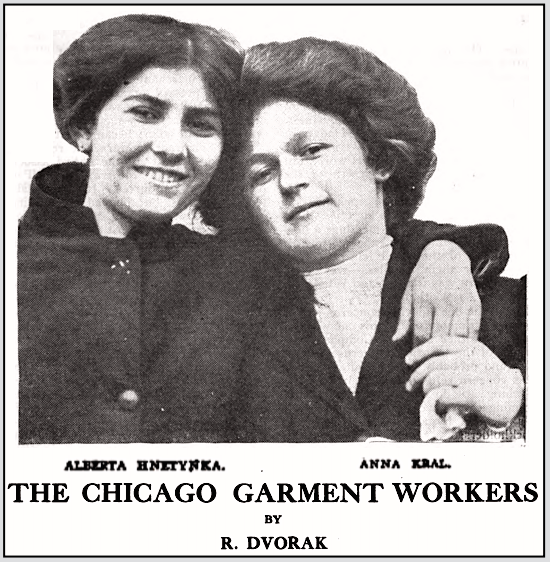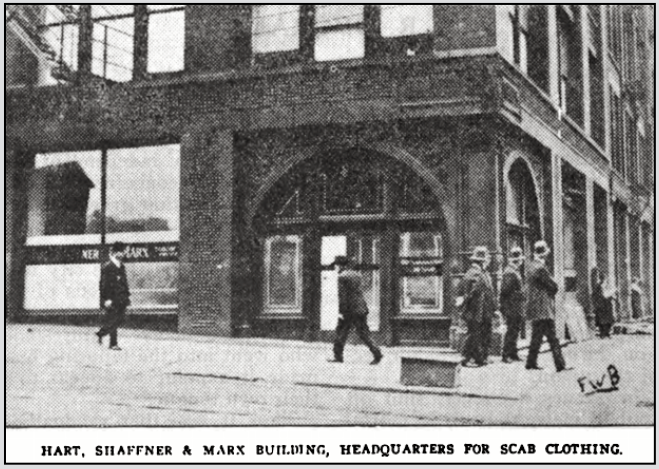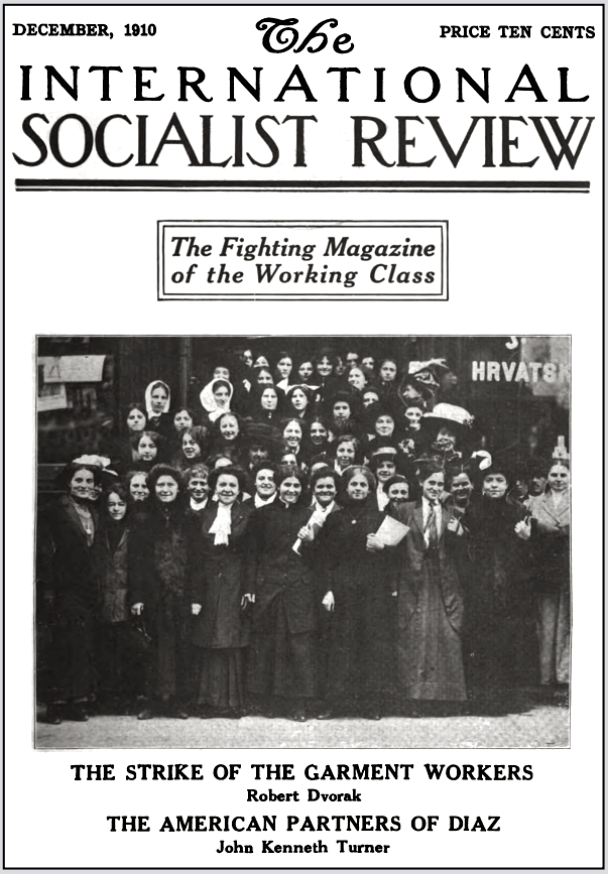 ———-
———-
Hellraisers Journal – Friday December 2, 1910
Chicago, Illinois – Report on Strike of 41,000 Garment Workers, Part I
From the International Socialist Review of December 1910:
[Part I.]
PERSONS who look upon the present Garment Workers’ strike in Chicago as a pure and simple labor battles are securing only an outward glimpse of the situation.
The strike itself, truly enough, was brought on by a revolt of the poor under paid girls and boys, men and women. It was a simultaneous upheaval of over 41,000 garment workers brought on by sixteen girls against petty persecution, low wages, abuse and long hours, an upheaval, unorganized at the start, which later took on the form of a fight for recognition of the union.
Behind the scenes, however, shut off from the public view, there is a mortal combat of big and small interests going on. A combat that is likely to settle, once for all, a battle of many years’ standing.
Like every other trustified industry, the production of clothing was at first limited to a number of independent manufacturers. These concerns unhampered by much competition grew to giant proportions.
Chicago, however, grew as rapidly as did the concerns. The city was soon divided into neighborhoods of various nationalities. Among these nationalities there were many venturesome persons who went into the tailoring business and made it a point to appeal to people of their own tongue.
Thus it was that gradually the business of the big concerns began to decrease. The more the city grew in population the more small tailor shops sprang up until they were growing, it seemed, over night, like mushrooms.
The big tailors tried various ways of curbing the slump in their business. They increased their volume of advertising. They hired agents. They tried every method known to the business world, but they failed to stop the growth of the cockroach tailors.
Then it was that the consolidation plan was resorted to. The big tailors held a meeting. After several meetings a new concern—one which was expected to curb the growth of the small fellows—or at least render them harmless—was born. This concern was the Chicago Wholesale Clothiers’ Association.
All of the big tailoring concerns joined the association but one. This one was the Hart, Schaffner & Marx Company, the largest of the tailoring concerns in Chicago and probably in the United States. This concern refused absolutely to have anything to do with the association, claiming that it would not have its policies dictated by any one but its own stockholders.
Backed by millions of dollars, the association began a campaign of elimination. Agencies were established in different parts of the city and outfitted with salesmen of the nationality prevalent in the particular location. In this way the little struggling merchant tailor gradually began to be pressed against the wall until from sheer despair he was forced to accept work from the association. In this way the small tailors became contractors.
Hart, Schaffner & Marx, the renegade firm being fought by the entire association, plunged into the fray with all of its marvelous resources. It also established agencies, but instead of limiting itself to the city the firm spread itself all over the country. Almost every town has today a store known as the home of the Hart, Schaffner & Marx clothes.
The fight of the association against Hart, Schaffner & Marx was a hopeless one. Everywhere the renegade firm scored a victory until the combined powers gradually weakened in their fight and settled down to a campaign of tactics and strategy.
As an initial move, the association resorted to paying the contractors a higher price for work done and gloated over the expected victorious move. For a time it looked as though the association had scored a point, but all of a sudden Hart, Schaffner & Marx sprang a surprise that came like a thunderbolt from a clear sky.
Forty-eight shops were opened by the renegade firm. All of the work was taken away from the contractors. Over 8,000 tailors were hired and placed in the shops. And again the association ground its teeth with disappointment and rage. Once again the lonely renegade had scored on the combined interests and brains.
Finding itself defeated, the association began to vent its rage on the poor scape goat of a contractor. It cut the prices and raved over even the best work done. The contractor in turn cut the wages of his tailors and charged them for even insignificant errors. Thus little by little the germs of rebellion were being installed in the shops, waiting only for a proper moment to grow into threatening proportions.
Hart, Schaffner & Marx, finding itself independent and thoroughly entrenched, decided to reap a harvest while the sun shone. It began by cutting the wages of its employes at every opportunity. The foremen picked out the speediest workers in the shop and made pacemakers out of them by boosting the piece work rates until the highest figure possible was reached.
The foremen and superintendents were given bonuses every time they increased the productive capacity of the shop without increasing the payroll. Whenever a foreman happened to increase the number of garments produced in his shop and also decreased the expense of the firm he received an even higher bonus. This made the foremen money crazy and established a system in the shop that brought suffering and may yet be the means of damaging the firm itself.
Driven crazy with the bonus plan, the foremen resorted to the vilest methods ever installed in a shop. They gave orders to the floormen to shut off the water before and after dinner so that the employes, the majority of whom in many shops were girls, would have no occasion to leave their work.
A pass system was established in most of the other shops, where the employes objected strenuously to having the water shut off, and every worker had to first secure a pass in order to get a drink. Girls who were looked upon as leaders of the other workers in the shop were given positions as foreladies, with instructions to get out as much work as possible.
Bonuses were held in front of the foreladies also and they in turn generally did their best to grind the employes in order to win a bonus.
Gradually the employes in the shops began to gain courage and dissatisfaction began to walk rampant in the establishments. Then in order to smooth the ruffled feathers of the workers the piece work system was resorted to. The speediest and most experienced workers were placed on a piece-work basis. Their rates were increased from week to week until the high water mark was reached.
As soon as the foremen saw that the pace-maker was doing as much work as he or she was capable of, the rate was gradually lowered, but the same amount of work was required. The dissatisfaction, which had been quieted temporarily with the increased rate, began to grow once more.
There were complaints from married men and married women about the low wages. Person after person pleaded for a higher salary, complaining that the money earned was far from sufficient for a livelihood.
Girls and women who were earning but three to six dollars a week were told to take some of the work home with them in the evening. Many did this and worked until late into the night in an attempt to earn sufficient money to live on during the week.
Many of the girls working with needles sewing on buttons or other work, bought hundreds of needles at one time and threaded these at home so as to be able to work faster in the shops and thus make more money.
As soon as the girls made what the firm regarded as too much money, they forced the button sewers to draw the needle through the button six times in stead of three, as had been the custom. This increased the work on the button without increasing the pay. The girls objected, but were dismissed for their pains and blacklisted in many instances so that they could not secure work in any of the other Hart, Schaffner & Marx shops.
The rate and wage cutting system was becoming so general that secret meetings of the tailors were not uncommon. The indignities showered upon the employes were reviewed and discussed at these meetings and the rebellion gained a new impetus.
———-
[Emphasis added.]
~~~~~~~~~~~~~~~~~~~~~~
SOURCES & IMAGES
Rose Schneiderman Quote, Stand Together to Resist Mar 20,
-NY Independent p938, Apr 1905
https://babel.hathitrust.org/cgi/pt?id=coo.31924106546991&view=2up&seq=962
The International Socialist Review, Volume 11
(Chicago, Illinois)
July 1910-June 1911
https://www.marxists.org/history/usa/pubs/isr/
https://books.google.com/books?id=8-05AQAAMAAJ
ISR-Dec 1910
https://www.marxists.org/history/usa/pubs/isr/v11n06-dec-1910-ISR-gog-Corn-OCR.pdf
https://play.google.com/books/reader?id=8-05AQAAMAAJ&printsec=frontcover&pg=GBS.PA320-IA3
-page 353: “The Chicago Garment Workers” by Robert Dvorak
https://play.google.com/books/reader?id=8-05AQAAMAAJ&printsec=frontcover&pg=GBS.PA353
See also:
Chicago Garment Workers’ Strike of 1910
https://en.wikipedia.org/wiki/1910_Chicago_garment_workers%27_strike
Rose Schneiderman’s full quote:
From the NY Independent of April 1905:
-935: “A Cap Maker’s Story”
-written by RS, New York, March 20, 1905
https://play.google.com/books/reader?id=SpZAAQAAMAAJ&hl=en&pg=GBS.PA935
https://www.digitalhistory.uh.edu/voices/social_history/12capmaker.cfm
-938: Quote “Stand Together to Resist”
https://babel.hathitrust.org/cgi/pt?id=coo.31924106546991&view=2up&seq=962
https://play.google.com/books/reader?id=SpZAAQAAMAAJ&hl=en&pg=GBS.PA938
The girls and women by their meetings and discussions come to understand and sympathize with each other , and more and more easily they act together.
It is the only way in which they can hope to hold what they now have or better present conditions.
Certainly there is no hope from the mercy of the bosses.
Each boss does the best he can for himself with no thought of the other bosses, and that compels each to gouge and squeeze his hands to the last penny in order to make a profit.So we must stand together to resist, for we will get what we can take-just that and no more.
NEW YORK , March 20, 1905.
~~~~~~~~~~~~~~~~~~~~~~~~~~~~~~~~~~~~~~~~~~~~~
Union Maid – New Harmony Sisterhood Band



